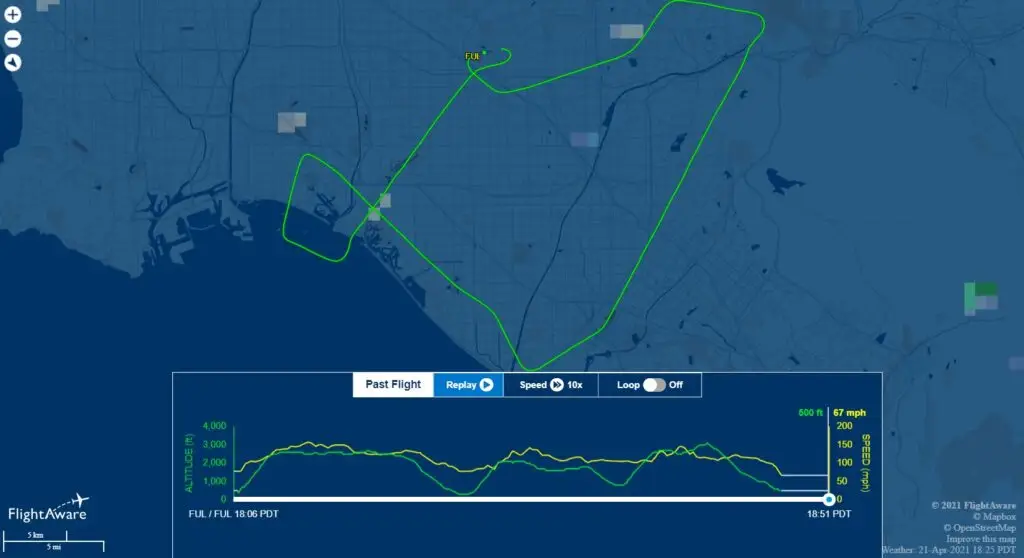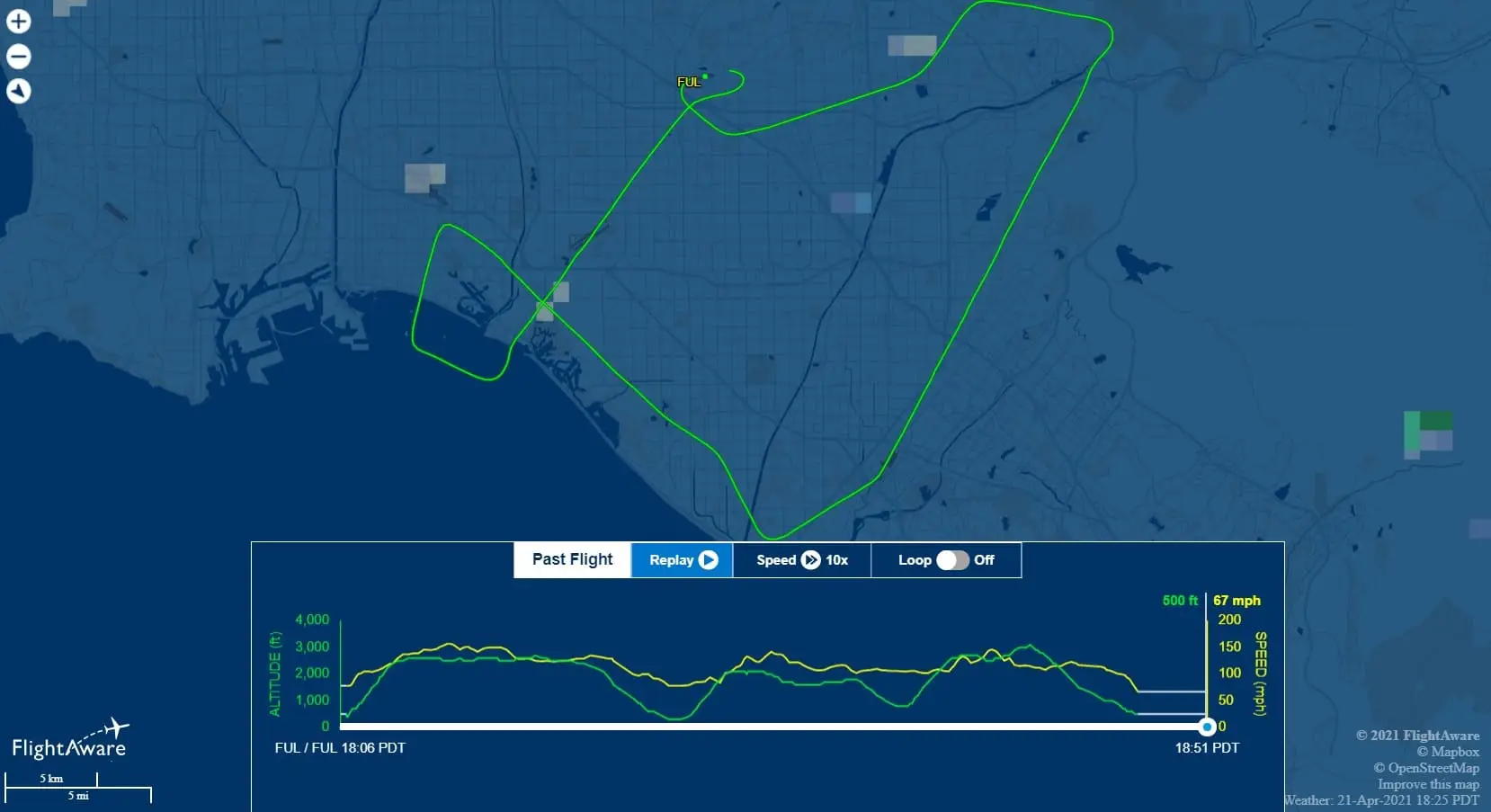IFR training flight 11 was to take place in the evening on the 14th. I was doing pre-flight on the plane and heard some police sirens but didn’t think anything of it. However, after a few minutes went by without hearing any planes coming or going I walked out in front of my hangar, and looking down towards the runway I saw a number of police cars. There was a Remos that had been doing some pattern work, dug into the dirt on the side of the runway. The winds were shifting and a little gusty, the Remos is a very light plane, and it looked like he had ended up off the side of the runway and the nose wheel dug in. Everybody was ok, the pilot and another person pulled down on the empennage and walked it back to a hangar rolling on the main gear, but the runway was closed for a bit and my CFII who was returning from another training flight had to divert to Long Beach while waiting for the runway to reopen. Mistakes on landing can be very unforgiving.

Flight 11 – April 17th

Saturday the 17th was a beautiful clear day, perfect for flying multiple practice approaches. We decided on the same flight that we did on the 9th, a round-robin tour of Chino (KCNO), Corona (KAJO), and Fullerton (KFUL).
We picked up flight following and Tower handed us off to SoCal Approach shortly after lifting off. After the initial contact we were cleared to “resume own navigation” so I pulled up direct PDZ on the GPS and began a left turn. A few minutes later we were handed off to the next controller.
Me: “SoCal Approach, Mooney 78878, two thousand eight hundred climbing three thousand five hundred, and we would like the RNAV 26R practice approach if possible.”
SoCal: “Mooney 78878, depart paradise heading 080, Ontario altimeter 29.94.”
Me: “Depart Paradise zero-eight-zero, two-niner niner-four, eight seven eight.”
We leveled off at 3,500′ and I was keeping an eye on the distance to Paradise while watching my heading and altitude. I was even counting down the miles to go in an effort to stay focused, but got stuck in my scan long enough that I missed our arrival at Paradise and my CFII gave me a “begin your turn” reminder, the first of two on this flight.
We were vectored around and two turns later on a heading to intercept the final approach course. We intercepted final, I turned on course inbound, and we were handed off to the Tower. I was still high crossing the final approach fix 4.4 NM from the runway but brought the indicators in line and tracked the glideslope down before going missed. In our debrief after the flight my CFII told me if I find that I am going to be high at the FAF that I can always throw the gear out early to help get down.
Between the last flight and this one I played around with the GPS simulator on my computer to iron out some of the difficulties I had on the last flight hunting for button/screen sequences. That exercise helped and as we were climbing out I pulled up direct back to Paradise without fumbling around this time. We leveled off at 3,000′ and made a parallel entry into the holding pattern. For the second time on this flight he gave me a reminder to begin my turn as I missed beginning the turn back into the hold.
The VOR-A Approach into Corona went better this flight than the previous flight. At the missed approach point I glanced down out the side window to see the airport right below us then began a turn and climb out to the west back to Fullerton to fly the GPS approach to runway 24.
I try to take away at least one point from each flight to file away for the future. This time it was to put the gear out early if needed to get down. For some reason I was stuck on putting the gear out just prior to the final approach fix. However, the goal of flying the approach is to be established and stabilized which is difficult if you are coming down fast. Dropping the gear down a little early for that extra drag to get down and cross the FAF at the correct altitude will result in a much more stable trip down the glideslope inside the FAF.
Flight 12 – April

The ceilings were too low to do any practice approaches at fields to the north and east so we went south instead. Once again it would be a round-robin to fly multiple approaches at different airports. Given the close proximity it would be another busy flight, but the way to stretch your mind and improve your skills is by getting to that saturation point, which will move it a little further away the next time, like exercising a muscle. We briefed the flight. We would pick up flight following to John Wayne (KSNA) and shoot the RNAV Y RWY 20R approach with a touch and go at John Wayne. That would be followed by the RNAV Z RWY 30 approach at Long Beach (KLGB) which would be a missed approach and then vectors back to fly the VOR-A Practice Approach into Fullerton (KFUL) for a full stop landing.
I told my CFII that on this departure, rather than waiting until we made the turn and were handed off to SoCal to put on the foggles that I would give him control of the plane right after I raised the gear and put the foggles on.
After completing the run-up and going through the pre-takeoff checklist to configure for departure I called up Ground.
Me: “Fullerton Ground, Mooney 78878 in the south-east run up, requesting flight following to John Wayne with Charlie.”
Ground: “Mooney 78878, Fullerton Ground, on departure left turn to heading 120, contact SoCal Approach frequency 125.35, squawk 0221.”
Me: “On departure left turn heading 120, frequency 125.35, squawk 0221, eight-seven-eight.”
Ground: “Mooney 878, readback correct, confirm you have information Charlie.”
Me: “We do have Charlie.”
After receiving taxi clearance we taxied to runway 24 and after waiting for landing traffic we were cleared to depart. Once climbing out I pulled up the gear and gave him the plane.
Me: “You have the controls.”
CFII: “I have the controls.”
Me: “You have the controls.”
Handing off the controls should be a three step procedure to make sure both of you know who is flying the plane. I let go of the yoke, grabbed the foggles, and put them on, and then got control of the plane back before beginning my left turn and getting handed off to SoCal Approach.
On the initial callup I asked for the practice approach and we were given vectors and told to climb and maintain 2,500. As anticipated things happened fast and the approach controller was busy with multiple planes on the frequency which requires more concentration to make sure you don’t miss a call for your plane. Established inbound on the approach but not yet at the final approach fix I was given this instruction from ATC.
SoCal: “Mooney 78878, maintain 130 knots until a three mile final.”
I was at the saturation point, that spot where your brain is really doing all it can and anything else thrown on top is not going to either compute or maybe even register. It really is a strange feeling and not one I recall experiencing until I started flying. So, being at the saturation point I just repeated back to the controller his instructions without even thinking if I could comply with them.
Me: “Maintain on-three-zero knots until three mile final, eight-seven-eight.”
In about the next 2-3 seconds the following went through my mind. I don’t think in knots very often because everything in my plane is in miles, but I glanced over at my airspeed indicator which was showing about 130 mph. I saw the inner circle that showed knots and that 130 knots is roughly 150 miles per hour. My gear extension speed is 120 mph. If i was to speed up to comply with his instructions there is no way possible to slow from 150 mph to 120 mph, get the gear down, and land from 3 miles out. I looked over towards my CFII and said “We can’t do that in this plane.” He keyed the microphone,
CFII: “Approach, Mooney 878, we’re unable to do that, if you need give us vectors to box us around again that is fine.”
Approach: “Just maintain your current speed until three mile final.”
CFII: “Roger, maintain current speed to three mile final.”
Right after that exchange we were handed off to John Wayne Tower.
Me: “John Wayne Tower, Mooney 78878 on the RNAV 20R Practice Approach.”
Tower: “Mooney 78878, two-zero right, cleared to land.”
Me: “We’d like the option if we can get it.”
Tower: “Mooney 878, are you going to be working in the pattern or are you guys departing?”
Me: “We’ll be departing and then going to the RNAV Zulu 30 approach into Long Beach.”
Tower: “Mooney 878, runway two-zero right, cleared for the option.”
Me: “Two-zero right cleared for the option, eight-seven-eight.”
At about four miles out I pulled some power and leveled off momentarily to get from 130 mph down to 120 mph and put out my gear, then continued on down the glideslope. The DA (Decision Altitude) for the approach is 255′ AGL which is 200′ above the touchdown elevation. I was calling out the altitude as we descended through each 100′ and at 300′ I pulled off the foggles and there was the runway. We slowed a little more and I put in two pumps of flaps. In the pre-flight briefing I had explained to my CFII that I was only going to use take-off flap setting for the landing as we were going to be performing a touch and go.
Runway 20R at John Wayne is 5,700′ long which is a lot of runway to work with. We touched down, I made sure we were tracking down the centerline, I adjusted the trim as we were rolling out, and then added throttle back in and we were airborne quickly.
Tower: “Mooney 878, on the go fly heading 220.”
Me: “Heading 220, 878.”
We began the climb out and made the turn.
Tower: “Mooney 878, contact departure 125.35, see ya.”
Me: “one-two-five point three-five, eight-seven-eight.”
A little under five miles later we were intercepting the approach and getting handed off the Long Beach tower who cleared us to land. I said we were going to go missed and we were instructed to begin a turn to the south before reaching the runway. the approach went very well and on short final we began a climbing left turn back to the south, got handed off back to SoCal, and then vectored for the approach back into KFUL.
This would be the third time I flew the VOR-A into KFUL and was the best I had flown that approach.
The learning point on this flight was something that pilots are taught from the beginning. When you are flying, you are the Pilot in Command (PIC). It is your responsibility to fly the plane safely within both yours and the plane’s capabilities. If Air Traffic Control asks you do to something that you or the plane are not able to do, reply “unable” which is what I should have done when I was asked to maintain 130 knots on approach into John Wayne. If you tell the controller “unable” he/she will find another way to accommodate you and the other traffic. In this case he could vector me off, he could ask following traffic to slow down if possible, he could vector that traffic around, or ask me for something else, which is what he ended up doing by asking me to maintain current speed. There is always something to learn from every flight, this one was a good reminder of a lesson I learned years ago in my primary training.


